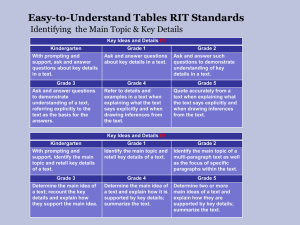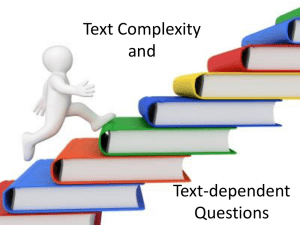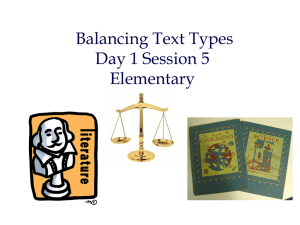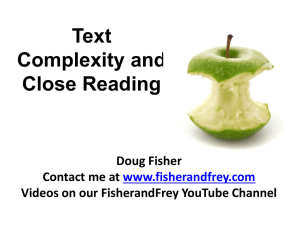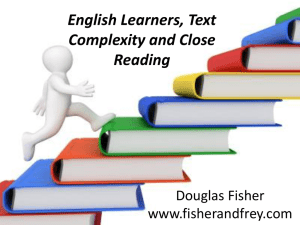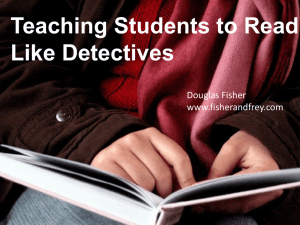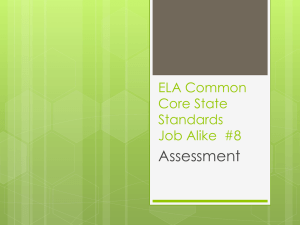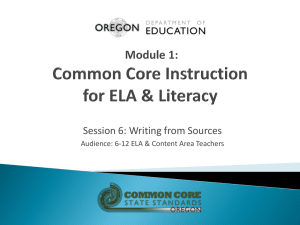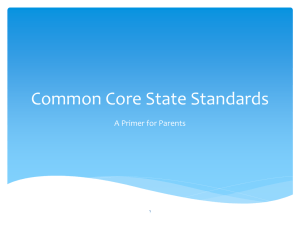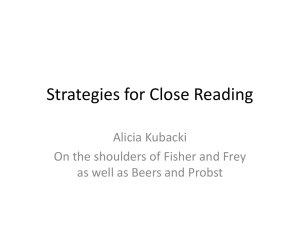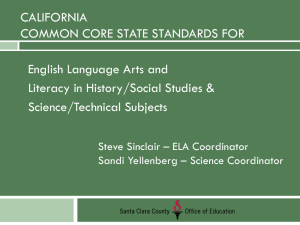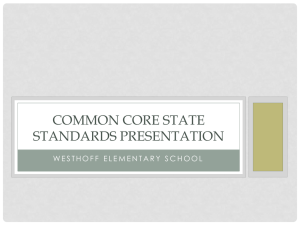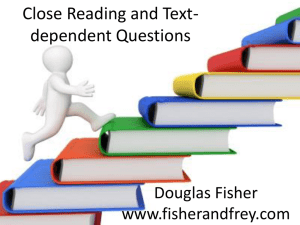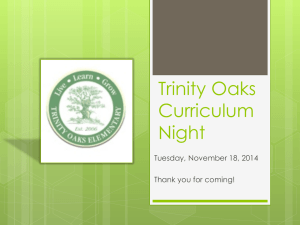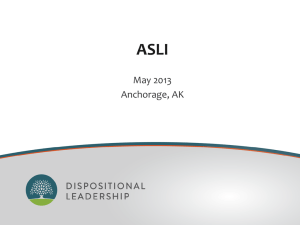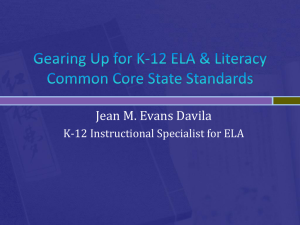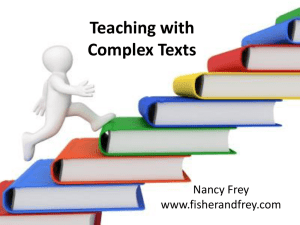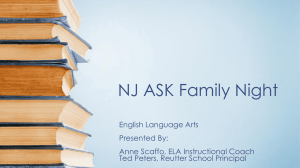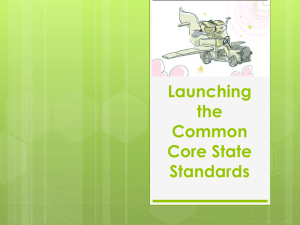CCSS ELA Parent Night - Marengo Elementary
advertisement
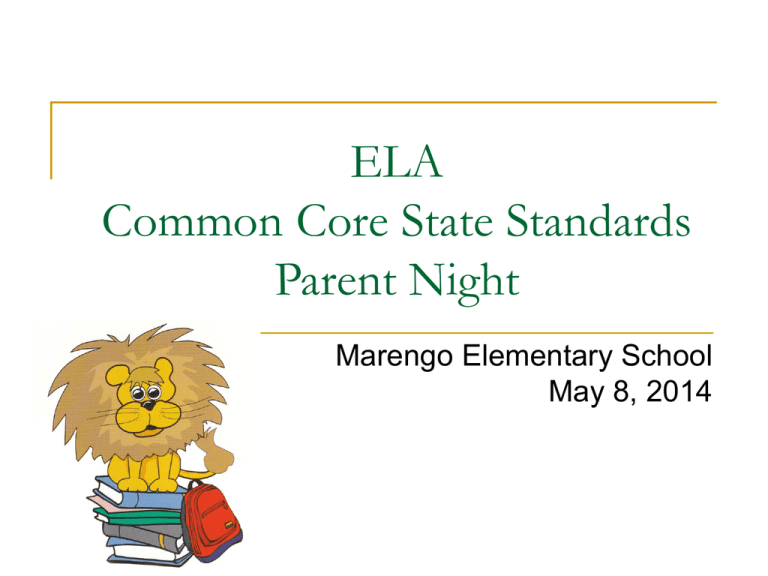
ELA Common Core State Standards Parent Night Marengo Elementary School May 8, 2014 Benjamin Franklin once said . . . . . Tell me and I forget. Teach me and I remember. Involve me and I learn. Why do we need the CCSS? Establish a clear and consistent progression of K-12 standards Prepare students for greater success in college and their careers Same expectations for all students, regardless of where one lives Collaboration with other states – work smarter Reduce costs by pooling resources International benchmarking – global competition The National Initiative Establish standards in Mathematics and Language Arts, and literacy in English Language Arts in History/Social Studies, Science & Technical Subjects Developed by the Council of Chief State School Officers and the National Governor’s Association Center for Best Practices. California was one of 48 participating states Parents, educators, content experts, researchers, national organizations and community groups Formally released on June 2, 2010 The California Initiative Senate Bill (SB) X5 1 signed January 2010 Academic Content Standards Commission Mathematics and Language Arts 85% required to be from CCSS; 15% from current standards added by California to ensure rigor Adopted by the State Board of Education on August 2, 2010 Joined the SMARTER Balanced Assessment Consortium (SBAC), June 9, 2011 CCSS: Content Plus Practice ELA Common Core State Standards Four strands: Reading, Writing, Speaking and Listening, and Language. + Strand specific College and Career Readiness (CCR) Anchor Standards that are identical across all grade levels and content areas. ELA: College & Career Ready “The CCR standards anchor the document and define general, cross disciplinary literacy expectations that must be met for students to be prepared to enter college and workforce training programs ready to succeed. The K-12 grade specific standards define end of year expectations and a cumulative progression designed to enable students to meet college and career readiness expectations no later than the end of high school.” (CCSS Introduction p. 4) Vocabulary Acquisition and Use Knowledge of Language Speaking and Listening Strand Conventions of Standard English Presentation of Knowledge and Ideas Writing Strand Comprehension and Collaboration Range of Writing Research to Build Knowledge Production and Distribution of Writing Reading Strand Text Types and Purposes Range of Reading and Level of Text Complexity Integration of Knowledge and Ideas Craft and Structure Key Ideas and Details English Language Arts Common Core Standards Language Strand Shift 1 Balancing Informational and Literary Text Students read (listen in K-2) a true balance of informational and literary texts (50/50) in ELA, science, social studies, technical subjects and the arts. Shift 2 Knowledge in the Disciplines Students build knowledge about the world (domains/ content areas) through TEXT rather than the teacher or activities. Staircase of Complexity; Read complex texts independently) Students read the central, grade appropriate text around which instruction is centered. Teachers are patient, create more time and space and support in the curriculum for close reading. Teachers provide the necessary scaffolding and support so that all students can participate. Text-based Questions and Tasks Students engage in rich and rigorous evidence based conversations. The majority of questions and tasks require careful scrutiny of the text in question (content, structure, and craft) and specific references to evidence to support responses Writing from Sources with an Increasing Focus on Argument and Informative Writing Writing emphasizes use of evidence from sources to inform or make an argument. Students support their presentation of ideas, information, or claims with specific and relevant evidence drawn from reading and research. Academic Vocabulary Students constantly build the transferable vocabulary they need to access grade level complex texts. This can be done effectively by spiraling like content in increasingly complex texts. Shift 3 Shift 4 Shift 5 Shift 6 Close reading is an ongoing and recursive process where students go back to the text based on the questions they are asked to look for evidence and really grasp a deep level of understanding of that text. 11 Short passage Complex text Limited frontloading Repeated readings Text-dependent questions Creating a Close Reading Progression of Text-dependent Questions Whole Opinions, Arguments, Intertextual Connections Across texts Entire text Inferences Segments Author’s Purpose Paragraph Vocab & Text Structure Sentence Key Details Word General Understandings Part General Understandings Overall view Sequence of information Story arc Main claim and evidence Gist of passage General Understandings in Kindergarten Retell the story in order using the words beginning, middle, and end. Key Details Search for nuances in meaning Determine importance of ideas Find supporting details that support main ideas Answers who, what, when, where, why, how much, or how many. Key Details in Kindergarten How long did it take to go from a hatched egg to a butterfly? What is one food that gave him a stomachache? What is one food that did not give him a stomachache? It took more than 3 weeks. He ate for one week, and then “he stayed inside [his cocoon] for more than two weeks.” Foods that did not give him a stomachache Apples Pears Plums Strawberries Oranges Green leaf Foods that gave him a stomachache Chocolate cake Ice cream Pickle Swiss cheese Salami Lollipop Cherry pie Sausage Cupcake watermelon Vocabulary and Text Structure Bridges literal and inferential meanings Denotation Connotation Shades of meaning Figurative language How organization contributes to meaning Vocabulary in Kindergarten How does the author help us to understand what cocoon means? There is an illustration of the cocoon, and a sentence that reads, “He built a small house, called a cocoon, around himself.” Author’s Purpose Genre: Entertain? Explain? Inform? Persuade? Point of view: First-person, third-person limited, omniscient, unreliable narrator Critical Literacy: Whose story is not represented? Author’s Purpose in Kindergarten Who tells the story—the narrator or the caterpillar? A narrator tells the story, because he uses the words he and his. If it was the caterpillar, he would say I and my. Inferences Probe each argument in persuasive text, each idea in informational text, each key detail in literary text, and observe how these build to a whole. Inferences in Kindergarten The title of the book is The Very Hungry Caterpillar. How do we know he is hungry? The caterpillar ate food every day “but he was still hungry.” On Saturday he ate so much food he got a stomachache! Then he was “a big, fat caterpillar” so he could build a cocoon and turn into a butterfly. Opinions, Arguments, and Intertextual Connections Author’s opinion and reasoning (K-5) Claims Evidence Counterclaims Ethos, Pathos, Logos Rhetoric Links to other texts throughout the grades Opinions and Intertextual Connections in Kindergarten Narrative Informational Is this a happy story or a sad one? How do you know? How are these two books similar? How are they different? Analyzing Text Grade 5/ELA/Nonfiction CCSS Reading Standards for Informational Text Key Ideas and Details 5.1 – Quote accurately from a text when explaining what the text says explicitly and when drawing inferences from the text. Writing Standards Text Types and Purpose 5.2b – Develop the topic with facts, definitions, concrete details, quotations, or other information and examples related to the topic. Speaking and Listening Comprehension and Collaboration 5.1 – Engage effectively in a range of collaborative discussions with diverse partners on grade 5 topics and texts, building on others’ ideas and expressing their own clearly. https://www.teachingchannel.org/videos/analyzing-text-lesson CCSS Testing: SBAC/CAASPP SBAC: Smarter Balanced Assessment Consortium CAASPP: California Assessment of Student Performance and Progress Replaces the CST Pilot Testing / Spring 2014 Implemented / Spring 2015 Taken in the Spring for students in grades 3, 4 and 5 for ELA and Math Involves; selected response, constructed response, and performance tasks Computer Adaptive IEP and 504 Adaptive http://www.smarterbalanced.org/ How will the National Assessments be different than the STAR? Summative assessments aligned to College and Career Readiness Standards Computer adaptive Administered during last 12 weeks of school year Results will show achievement and growth Question types: 1. Selected Response 2. Constructed Response 3. Performance –Based Tasks 5. Technology-Enhanced Distribution of Literacy and Informational Passages by Grade Grade Literature Information 4 50% 50% 8 45% 55% 12 30% 70% Grade 4 ELA Technology Enhanced Example Passage Grade 4 ELA Technology Enhanced Example Student Question Grade 3 ELA Example Constructed Response Grade 3 ELA Reading and Writing Performance-Based Assessment Part 1 includes reading an article and watching a video then providing a constructed response to three questions to demonstrate comprehension Part 2: Write an Opinion Essay using evidence from the video and article to support their opinion on the topic. Rubric for proficient Smarter Balanced Assessment Consortium (SBAC) http://www.smarterbalanced.org/practice-test/
